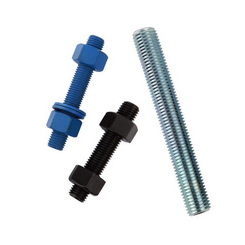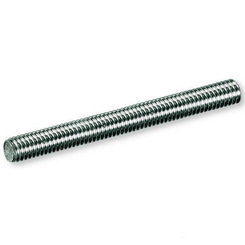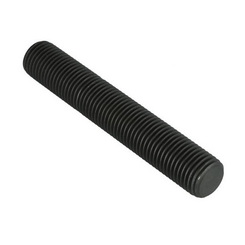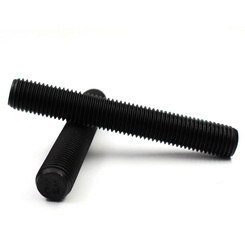 |
|
|
|
|
|
|
|
|
|
| DIN976 Studs Specification-NINGBO BOLT |
|
|
 |
 |
 |
 |
|
|
ISO 898-1 Specification
This part of ISO 898 specifies mechanical and physical properties of bolts, screws and studs made of carbon steel and alloy steel when tested at an ambient temperature range of 10 <C to 35 <C. Fasteners ! the term used when bolts, screws and studs are considered all together ! that conform to the requirements of this part of ISO 898 are evaluated at that ambient temperature range. They might not retain the specified mechanical and physical properties at elevated temperatures (see Annex B) and/or lower temperatures.
ISO 898-1 Chemical Composition
| Property class | Material and heat treatment | Chemical composition limits | Tempering temperature | ||||
| (cast analysis, %) a | ,c | ||||||
| c | p | s | a • | nin. | |||
| min. | max. | max. | max. | max. | |||
| 4.6 c, d | Carbon steel or carbon steelwith additives | - | 55 | 0.05 | 0,060 | Not specified | - |
| 4.8 d | |||||||
| 5.6 c | 13 | 55 | 0.05 | 0,060 | |||
| 5.8 d | - | 55 | 0.05 | 0,060 | |||
| 6.8 d | 15 | 55 | 0.05 | 0,060 | |||
| 8.8 f | Carbon steel with additives (e.g. Boron or Mn or Cr) quenched and tempered | 15 | 40 | 0.025 | 0,025 | 0,003 | 425 |
| or | 25 | 55 | 0.025 | 0,025 | |||
| Carbon steel quenched and tempered | |||||||
| or | 20 | 55 | 0.025 | 0,025 | |||
| Anoy steelquenched and tempered 9 | |||||||
| 9.8 f | Carbon steel with additives (e.g. Boron or Mn or Cr) quenched and tempered | 15 | 40 | 0,025 | 0,025 | 0,003 | 425 |
| or | 25 | 55 | 0.025 | 0,025 | |||
| Carbon steel quenched and tempered | |||||||
| or | 20 | 55 | 0.025 | 0,025 | |||
| Alloy steelquenched and tempered 9 | |||||||
| 10.9 f | Carbon steel with additives (e.g. Boron or Mn or Cr) quenched and tempered | 0,20 . | 55 | 0,025 | 0,025 | 0,003 | 425 |
| or | 25 | 55 | 0.025 | 0,025 | |||
| Carbon steel quenched and tempered | |||||||
| or | 20 | 55 | 0,025 | 0,025 | |||
| Alloy steel quenched and tempered 9 | |||||||
| 12..9 f.h.i | Alloy steel quenched and tempered 9 | 30 | 50 | 0.025 | 0,025 | 0,003 | 425 |
| 12..9 f.h.i | Carbon steel with additives (e.g. Boron or Mn or Cr or Molybdenum)quenched and tempered | 28 | 50 | 0.025 | 0,025 | 0,003 | 380 |
Note:
a. In case of dispute, the product analysis applies.
b. Boron content can reach 0,005 %, provided that non-effective boron is
controlled by addition of titanium and/or aluminium.
c. For cold forged fasteners of property classes 4.6 and 5.6, heat treatment of
the wire used for cold forging or of the cold forged fastener itself may be
necessary to achieve required ductility.
d. Free cutting steel is allowed for these property classes with the following
maximum sulphur, phosphorus and lead contents: sulphur 0,34 %; phosphorus 0,11
%; lead 0,35 %.
e. In case of plain carbon boron steel with a carbon content below 0,25 % (cast
analysis), the minimum manganese content shall be 0,6 % for property class 8.8
and 0,7 % for 9.8 and 10.9.
f. For the materials of these property classes, there shall be a sufficient
hardenability to ensure a structure consisting of approximately 90 % martensite
in the core of the threaded sections for the fasteners in the ^as-hardened ̄
condition before tempering.
g. This alloy steel shall contain at least one of the following elements in the
minimum quantity given: chromium 0,30 %, nickel 0,30 %, molybdenum 0,20 %,
vanadium 0,10 %. Where elements are specified in combinations of two, three or
four and have alloy contents less than those given above, the limit value to be
applied for steel class determination is 70 % of the sum of the individual limit
values shown above for the two, three or four elements concerned.
h. A metallographically detectable white phosphorus enriched layer is not
permitted for property class 12.9/12.9. It shall be detected by a suitable test
method.
i. Caution is advised when the use of property class 12.9/12.9 is considered.
The capability of the fastener manufacturer, the service conditions and the
wrenching methods should be considered. Environments may cause stress corrosion
cracking of fasteners as processed as well as those coated.
ISO 898-1 Mechanical Requirements
|
No. |
Mechanical or physical property |
Property class |
||||||||||
|
4.6 |
4.8 |
5.6 |
5.8 |
6.8 |
8.8 |
9.8 |
10.9 |
12.9/ 12.9 |
||||
|
d+ |
d > |
|||||||||||
|
1 |
Tensile strength, Rm, MPa |
nom.c |
400 |
500 |
600 |
800 |
900 |
1000 |
1200 |
|||
|
min. |
420 |
500 |
520 |
600 |
800 |
830 |
900 |
1040 |
1220 |
|||
|
2 |
Lower yield strength, ReL d, MPa |
nom.c |
240 |
- |
300 |
- |
- |
- |
- |
- |
- |
- |
|
min. |
240 |
- |
300 |
- |
- |
- |
- |
- |
- |
- |
||
|
3 |
Stress
at 0,2 % non, proportional elongation, |
nom.c |
- |
- |
- |
- |
- |
640 |
640 |
720 |
900 |
1080 |
|
min. |
- |
- |
- |
- |
- |
640 |
660 |
720 |
940 |
1100 |
||
|
4 |
Stress at 0,0048 d non-proportional elongation for full-size fasteners, Rpf, MPa |
nom.c |
- |
320 |
- |
400 |
480 |
- |
- |
- |
- |
- |
|
min. |
- |
340e |
- |
420e |
48e |
- |
- |
- |
- |
- |
||
|
5 |
Stress under proof load, Sp,f,MPa |
nom.c |
225 |
310 |
280 |
380 |
440 |
580 |
600 |
650 |
830 |
970 |
|
Proof strength ratio Sp,nom/ReL min or Sp,nom/Rp0,2 min or Sp,nom/Rpf min |
min. |
094 |
091 |
0.93 |
090 |
0.92 |
0.91 |
0.91 |
0.90 |
0.88 |
0.88 |
|
|
6 |
Percentage elongation after fracture for machined test pieces, A, % |
min. |
22 |
- |
20 |
- |
- |
12 |
12 |
10 |
9 |
8 |
|
7 |
Percentage reduction of area after fracture for machined test pieces, Z, % |
min. |
- |
52 |
48 |
48 |
44 |
|||||
|
8 |
Elongation after fracture for full-size fasteners, Af (see also Annex C) |
min. |
- |
0.24 |
- |
0.22 |
0.20 |
- |
- |
- |
- |
- |
|
9 |
Head soundness |
No fracture |
||||||||||
|
10 |
Vickers hardness, HV F W 98 N |
min. |
120 |
130 |
155 |
160 |
190 |
250 |
255 |
290 |
320 |
385 |
|
max. |
220 g |
250 |
320 |
335 |
360 |
380 |
435 |
|||||
|
11 |
Brinell hardness, HBW F = 30 D2 |
min. |
114 |
124 |
147 |
152 |
181 |
238 |
242 |
276 |
304 |
366 |
|
max. |
209 g |
238 |
304 |
318 |
342 |
361 |
414 |
|||||
|
|
Rockwell hardness, HRB |
min. |
67 |
71 |
79 |
82 |
89 |
! |
||||
|
max. |
95,0 g |
99,5 |
! |
|||||||||
|
Rockwell hardness, HRC |
min. |
- |
22 |
23 |
28 |
32 |
39 |
|||||
|
max. |
- |
32 |
34 |
37 |
39 |
44 |
||||||
|
13 |
Surface hardness, HV 0,3 max. |
! |
h |
h, i |
h, j |
|||||||
|
14 |
Height of non-decarburized thread zone, E, mm |
min. |
! |
1/2 H1 |
2 /3 H1 |
3 /4H1 |
||||||
|
Depth of complete decarburization in the thread, G, mm |
max. |
! |
0,015 |
|||||||||
|
15 |
Reduction of hardness after retempering, HV |
max. |
! |
20 |
||||||||
|
16 |
Breaking torque, MB, Nm |
min. |
! |
in accordance with ISO 898-7 |
||||||||
|
17 |
Impact strength, KV k, l, J |
min. |
! |
27 |
! |
27 |
27 |
27 |
27 |
m |
||
|
18 |
Surface integrity in accordance with |
ISO 6157-1 n |
ISO 6157-3 |
|||||||||
Note:
a. Values do not apply for structural bolting.
b. For structural bolting d W M12.
c. Nominal values are specified only for the purpose of the designation system
for property classes. See Clause 5.
d. In cases where the lower yield strength ReL cannot be determined, it is
permissible to measure the stress at 0,2 % non-proportional elongation Rp0,2.
e. For the property classes 4.8, 5.8 and 6.8 the values for Rpf min are under
investigation. The present values are given for calculation of the proof stress
ratio only. They are not test values.
f. Proof loads are specified in Tables 5 and 7.
g. Hardness determined at the end of a fastener shall be 250 HV, 238 HB or 99,5
HRB maximum.
h. Surface hardness shall not be more than 30 Vickers points above the measured
core hardness of the fastener when determination of both surface hardness and
core hardness are carried out with HV 0,3.
i. Any increase in hardness at the surface which indicates that the surface
hardness exceeds 390 HV is not acceptable.
j. Any increase in hardness at the surface which indicates that the surface
hardness exceeds 435 HV is not acceptable.
k. Values are determined at a test temperature of −20 <C, see 9.14.
l.Applies to d W 16 mm.
m. Value for KV is under investigation.
n. Instead of ISO 6157-1, ISO 6157-3 may apply by agreement between the
manufacturer and the purchaser.
|
||||||||||
|
Copyright © Ningbo Steel Bolt Co., Ltd All Rights Reserved |

